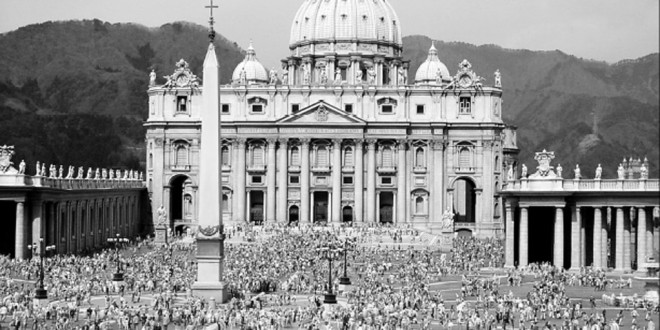By K. Paul Žygas
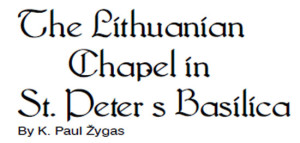
A TRIP TO ROME WITHOUT VISITING ST. Peter’s Basilica would be like going to a birthday party but missing out on the cake. This great church, one of the Eternal City’s principal monuments, is continuously open, even during repairs and restorations, and admission is free. But there is so much to see there that it is impossible to absorb it all in just a few short hours. Many overwhelmed and/or exhausted visitors leave without seeking out the tomb of Apostle Peter – the very reason why the basilica was built in the first place, why it stands on that particular site. And if they miss his venerable underground shrine, they will surely miss the Mater Misericordiae (Mother of Mercy) Lithuanian chapel, which is located just off on the left side of the stairs on the way down to the apostle’s final resting place.
The whereabouts of St. Peter’s remains are clearly indicated inside and outside the basilica. Its immense dome, as high as a forty-story building and visible from just about everywhere in Rome, announces their location centered directly under it in the crypts below. Inside it is impossible to miss the baldachino, or canopy, which covers and protects the Papal Altar. The pope celebrates Mass directly above the apostle’s tomb. The marble stairs fronting the baldachino lead down to a sunken chapel called the confessio where, set far back and deep inside behind an iron gate, St. Peter’s relics rest in peace.
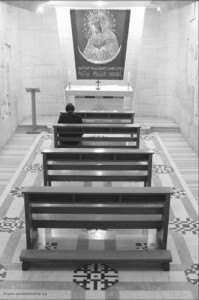
The way to the apostle’s shrine is thus as clear as can be to anyone who has set foot inside the basilica. But those of us who have put off their visit to St. Peter’s need not feel entirely left out. Several scenes in Angels and Demons, a film based on a novel by Dan Brown, take place in front of the confessio and within yards of the Lithuanian chapel. To understand how both of them came about, let us backtrack some in time.
After legitimizing Christianity around 320 AD, Emperor Constantine decided to build a grand new church in Rome. The chosen spot in the Vatican area was an old burial ground filled with tombs of pagan Romans and the first Christians. The emperor top-filled this necropolis, constructing Old St. Peter’s on the newlyleveled site. For centuries on end the underground city of the dead was left alone and lay mostly undisturbed. All the while oral tradition maintained that Apostle Peter was buried there. Excavations to ascertain whether his tomb was actually where Christians had long believed it to be began in 1940, and the location of St. Peter’s tomb was soon confirmed.
During the intervening centuries much had occurred to Old St. Peter’s. More than a thousand years old before the Renaissance had even begun, Christendom’s most hallowed site in Europe had resisted fires, earthquakes,and hostile vandals. Nonetheless, the passage of time had left its marks: the ancient frescoes were fading; mosaics were flaking off; venerable shrines were crumbling, and, most worrisome, the foundations had settled unevenly. Some upper walls were leaning six feet out of plumb!
Several popes considered repairing the fabric, but only Pope Julius II took the matter in hand. Rejecting all renovation proposals, in 1506 he laid down the cornerstone of a new basilica, the very one standing today. During the prolonged construction its design changed several times. Significant to our story, in 1538 the architect Antonio da Sangallo raised the floor level some ten feet. This created a basement sandwiched between the church being built and the ancient Roman necropolis. The earliest Christian crypts and St. Peter’s remains thus came to be two levels down, some twenty-four feet below the new basilica’s main floor.
Problem was this newly-created, intermediate basement was dark and cold, unlit and uncomfortable. For centuries it could only be visited with the help of candles and torches. In 1935 Pope Pius XI initiated an archaeological excavation and restoration project, which continued into the 1950s. On completion, St. Peter’s acquired a well-lit, commodious basement. This entire level became known as Le Sacre Grotte Vaticane – the Sacred Grottoes of the Vatican. The parts under the nave were reserved for papal tombs, while the area beneath the Papal Altar was large enough for several new chapels.
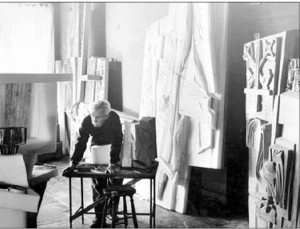
By then the Cold War was fully underway. The Soviet Union outlawed religion, repressed the faithful, and persecuted the clergy as a routine matter. The Vatican did not look the other way. In 1949 Pope Pius XII stunned left-leaning Italians, Frenchmen, and Spaniards by excommunicating all Roman Catholics who belonged to the Communist Party. The staunchly anticommunist pontiff also decided to reserve space in the Sacred Grottoes of the Vatican for the Churches of Silence behind the Iron Curtain. Every captive nation potentially qualified, but only the Hungarian, Polish, and Lithuanian chapels eventually materialized, a selection that was neither an obvious choice nor a foregone conclusion. Each chapel came about only because the Holy See agreed with the diplomats and churchmen of those particular countries that their cases truly merited the honor.
After World War II the envoys of pre-war independent Lithuania remained active in London, Paris, Washington, plus a few other capitals which questioned the Soviet annexation of the Baltic States. Stasys Lozoraitis led the dispersed Lithuanian diplomatic corps from his offices in Rome. As the Prime Minister of Lithuanian during the mid-1930s, he came to know Baron di Giura, Ambassador of Italy, and Antonio Samore, secretary of the Vatican nunciature, both of whom were stationed in Kaunas and became family friends. Sent to Italy in 1939 as Minister Plenipotentiary, Lozoraitis maintained these relationships in Rome for decades afterwards. We shall see that Baron Di Giura supported Lithuania throughout his career as did Antonio Samore, who, becoming a powerful cardinal, handled the Vatican’s international affairs.
Stasys Girdvainis represented Lithuania at the Vatican from 1939 onwards, at times rather tenuously. Diplomatic relations between the Vatican and the Soviet Union warmed up to such a point during the 1962 Cuban missile crisis that Pope John XXIII considered annulling the accreditation of pre-war Polish and Lithuanian envoys. Cardinal Samore opposed the idea, and Girdvainis remained, though in a somewhat diminished capacity. Had he been dismissed, the absence of an accredited Lithuanian diplomat at the Vatican would have made the creation of a Lithuanian chapel certainly much more difficult.
On May 5, 1967, Bishop Vincent Brizgys petitioned Pope Paul VI to create the Mater Misericordiae chapel in St. Peter’s Basilica. The bishop, auxiliary of the Kaunas diocese but living in Chicago, was the spiritual head of the Lithuanian émigré community. He also expressed the aspirations and grievances of Roman Catholics in occupied Lithuania to the free world. Brizgys submitted the formal request anticipating its acceptance. The diplomats Girdvainis, Lozoraitis, and Di Giuria, and churchmen, such as Cardinal Samore and Monsignor Paul Marcinkus, about whom more below, lobbied behind the scenes, significantly increasing the chances of a positive outcome.
The Lithuanian diaspora wholeheartedly supported the idea of the Mater Misericordiae chapel in St. Peter’s and began collecting funds. Late in 1967 the small but able community in Rome formed the Cappella Lituana committee. Consisting mostly of émigré churchmen, historians, and prominent laity, it also included Cardinal Samore, Francesco Vacchini, the basilica’s chief architect, and Monsignor Paul Marcinkus, future Archbishop and Vatican treasurer. Marcinkus, born in Cicero, Illinois, arrived in Rome in 1950. Mastering Italian, he sometimes served Pope John XXIII as his English translator. Early on the monsignor had also become a good friend of Giovanni Montini, who in 1963 was elected Pope Paul VI. Marcinkus then became his leading English translator, arranged the pontiff’s trips abroad, and was his personal bodyguard. Better access to the pope is hard to imagine.
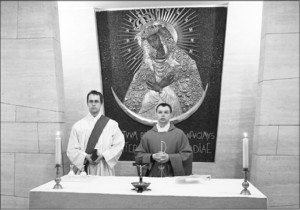
Bishop Brizgys entrusted the design of the Mater Misericordiae chapel to Vytautas Jonynas, an experienced artist already well-known to the Vatican. In 1958 Pope Pius XII decided to issue stamps commemorating the 500 year anniversary of St. Casimir, the patron saint of Lithuania. The pontiff wanted to draw attention to the plight of the Catholic Church in the occupied country. Jonynas was selected to prepare designs for 50 lira and 100 lira stamps, which, somewhat modified, were duly issued. Soon thereafter a competition was held for decorating the Vatican Chapel of the 1964-65 New York World’s Fair. Jonynas won commissions for the Holy Trinity bar-relief sculpture on the main façade, the unusual cross above the church, the main altar in the Good Shepherd’s Chapel, and an eye-catching monstrance. The artist personally attended to each one from design to delivery.
The Cappella Lituana committee and Vatican officials concurred that the Mater Misericordiae chapel should feature important aspects of Lithuania’s history and stress the country’s embrace of Christianity. Jonynas and the committee agreed that the chapel’s main panel should feature the Aušros Vartai Madonna, an iconic image of the Blessed Virgin Mary venerated in Vilnius since the 16th century. (The painting graces the chapel of the city gate whose name had been variously translated into English as Aurora Gate or Dawn Gate.) The envisioned chapel’s left wall would depict King Mindaugas, the country’s first Christian ruler, bas-reliefs of Jogaila and Vytautas, plus the image of a rūpintojėlis, a Lithuanian folk sculpture portraying a seated, sorrowful Christ. The wall on the right would start off with St. Casimir, the patron saint of Lithuania closest to altar, continue by commemorating Lithuanian martyrs, then a sculpted reference to the prayer book written by Lithuanian exiles in Siberia, and, lastly, the carved invocation “Marija, gelbėk mus” (Mary, save us.) All the other inscriptions would be in Latin.
The design was then submitted to a Vatican review committee for an up-or-down decision. No surprise that its members – the architect Francesco Vacchini, professors Fasolio and De Angelis Dossa, Archbishop Principi, and Conte Galeazzi, held divergent views. Those against any and all modernist additions to St. Peter’s Basilica opposed Jonynas’ design as a matter of principle. But, fortunately, a majority was won over and voted for the project. On July 28, 1968, Pope Paul VI granted final approval. The Mater Misericordiae chapel received the last remaining free spot in the Vatican’s grottoes.
Jonynas faced the daunting task of accommodating a rich visual program in a small chapel seating about a dozen. He unified the interior by covering its walls with cream-colored, unequally-sized travertine panels. To remind viewers of the early Christian catacombs and their crumbling frescoes, Jonynas left some areas bare with out any travertine. Sculptures and bas-relief figures were placed into these areas, their floor-to-ceiling fractured edges reminiscent of earthquake-damaged walls. The floor was laid with marble, serpentine, and porphyry tiles, patterned like the forms found on Lithuanian sashes; their colors recalling the Lithuanian flag. The ceiling was to have a mosaic with many star figures, their shapes as diverse as those crowning Lithuanian iron crosses. But since this would have detracted attention from the altar and art on the side walls, it is perhaps just as well that the star mosaic was omitted.
The Fabbrica di San Pietra, the company maintaining St. Peter’s basilica, did the chapel’s decorative work, the architect Vacchini supervising matters. The chapel’s altar was made from travertine; its Lithuanian cross faced the congregation. The Aušros Vartai Madonna image received an embossed silver cover; Angelo Bortolotti fashioned her crown. Alcido Tico cast the rūpintojėlis bronze sculpture, while Alfiero Nena made the chapel’s iron gate featuring the Vytis armorial. Vytautas Jonynas crafted all the bas-relief sculptures back in the United States. Visiting St. Peter’s afterwards, he was less than happy with Vacchini’s modifications of the original design and the Italian artists’ interpretations of the Vytis and the rūpintojėlis.
On the evening of July 6, 1970, Cardinal Paolo Marella, the Archpriest of St. Peter’s basilica, blessed the Mater Misericordiae chapel and consecrated its altar. The following morning Pope Paul VI, accompanied by Bishop V. Brizgys, Bishop A. Deksnys, and Paul Marcinkus, now a titular Archbishop, arrived at the chapel. The pontiff blessed the Aušros Vartai Madonna above the altar and lit the candle in the candelabra which he had donated. Since the chapel was too small for the crowd, it moved over a larger one nearby. Pope Paul VI celebrated Holy Mass in Latin; the gospel and hymns were in Lithuanian. After the service the pope spoke in Italian, Marcinkus promptly translating the address into English. (The full text of “Discorso del Santo Padre Paolo VI nelle grotte Vaticane, martedi, 7, luglio 1970” is available on the Internet.) Marcinkus then thanked the Holy Father on behalf of Lithuanians everywhere. Youth representatives gave the pontiff a rūpintojėlis amber statuette, specially made in their occupied homeland for the event. As Pope Paul VI was leaving the Lithuanian pilgrims spontaneously broke into their national anthem.
During the general papal audience held on July 8th, the following day, the pontiff briefly touched upon Lithuanian matters. A grand reception, held that evening in the courtyard of the Equestrian Order of the Holy Sepulcher’s palazzo, concluded the chapel’s inauguration on a festive note. Of the 500 or so at the gala event, Lithuanians from the United States and Canada numbered the most, followed by strong contingents from Germany, Australia, and South America. Vatican dignitaries and members of Rome’s diplomatic corps headed the formal guest list. The evening’s keynote speakers were, appropriately, Stasys Lozoraitis and Cardinal Samore, leading supporters of the entire Mater Misericordiae project.
In its own way the Lithuanian chapel actually returns a favor which the basilica extended to Vilnius ages ago. In the 1620s the construction of St. Peter’s neared completion, and many skilled craftsmen became available to take on other work. One such was the master mason Constantino Tencalla who had finished off the marble balustrade and marble stairs leading down into the confessio. His admirable craftsmanship caught the attention of Lithuanian churchmen visiting Rome. Tencalla was persuaded to travel to Vilnius and construct St. Casimir’s Chapel in the cathedral. This stunning marble interior is, arguably, the most Roman architectural work in the entire city. Centuries later Vytautas Jonynas reciprocated with the Mater Misericordiae chapel, certainly the most Lithuanian art work in St. Peter’s.
 DRAUGAS NEWS Lithuanian World Wide News in English
DRAUGAS NEWS Lithuanian World Wide News in English
